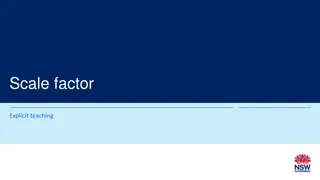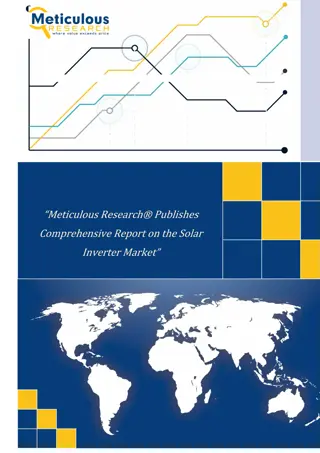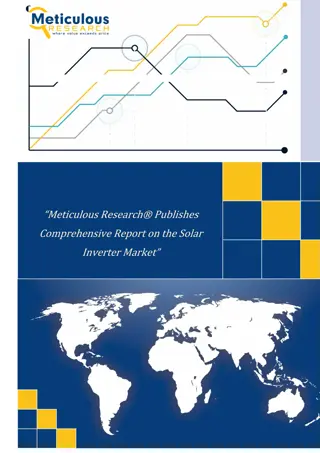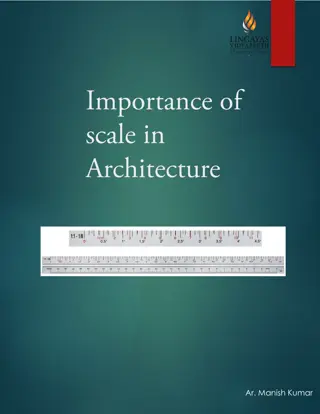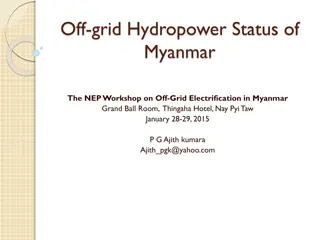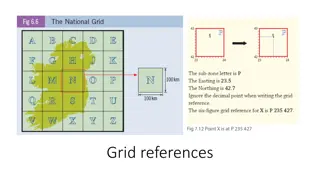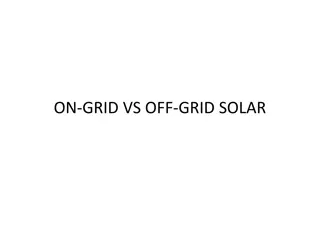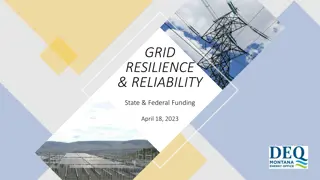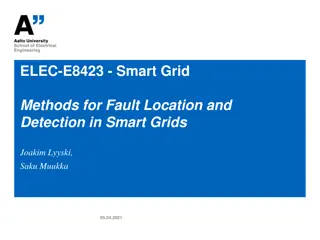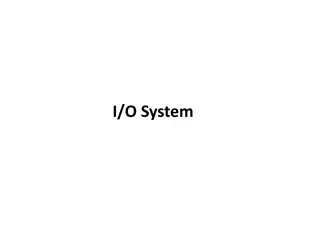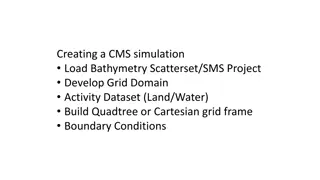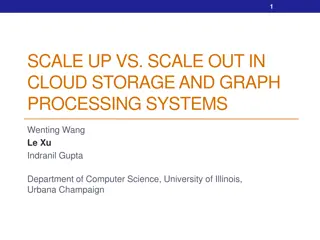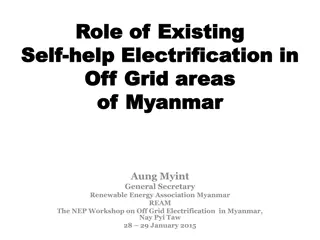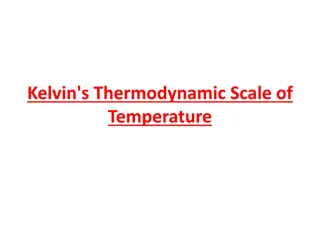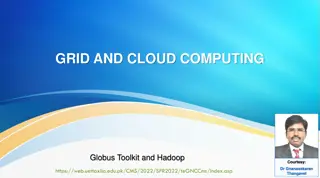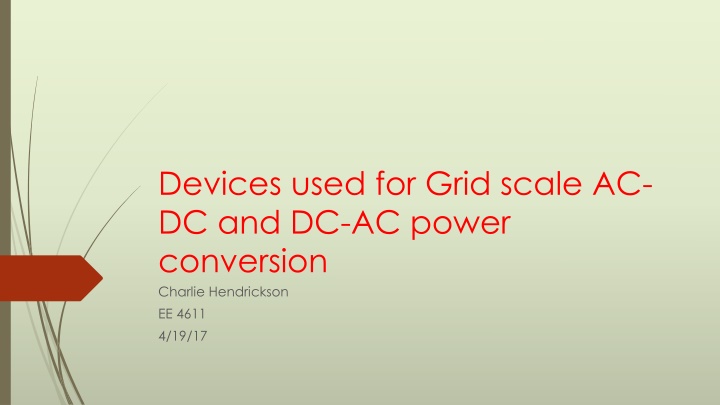
Devices for Grid-Scale Power Conversion | Application & Benefits
Explore the role of devices used in grid-scale AC-DC and DC-AC power conversion, including HVDC transmission, thyristors, current source converters, IGBTs, and VSCs. Learn where and why these devices are utilized, their efficiency advantages, and key points to consider. Discover the significance of HVDC technology in transmitting large amounts of power over long distances with minimal losses compared to AC.
Download Presentation

Please find below an Image/Link to download the presentation.
The content on the website is provided AS IS for your information and personal use only. It may not be sold, licensed, or shared on other websites without obtaining consent from the author. If you encounter any issues during the download, it is possible that the publisher has removed the file from their server.
You are allowed to download the files provided on this website for personal or commercial use, subject to the condition that they are used lawfully. All files are the property of their respective owners.
The content on the website is provided AS IS for your information and personal use only. It may not be sold, licensed, or shared on other websites without obtaining consent from the author.
E N D
Presentation Transcript
Devices used for Grid scale AC- DC and DC-AC power conversion Charlie Hendrickson EE 4611 4/19/17
Overview Where these devices would be used Why High Voltage Direct Current (HVDC) transmission Thyristors Current Source Converters (CSC) Insulated Gate Bipolar Transistors (IGBT) Voltage Source Converters (VSC) Summary References 5 Key points
Where would these devices be used HVDC transmission Large amounts of energy over long distances Lot of the optimal locations for renewables are long distances from load Renewable energy Solar Photo Voltaic produces DC Wind and Hydro variable output AC/DC by inserting DC link able to sync with 60 Hz Grid
Why HVDC? DC is more efficient than AC for transmitting large amounts of power over long distances 3,500 MW transmission line, 600 mi. long Losses on AC line ~ 15% Losses on DC line ~ 4.54% Only 2 conductors vs. 9 (3 per phase) Smaller towers require less right of way Break even distances 600 km (373 mi.) for above ground lines 50 km (31 mi.) for submarine lines Allows two unsynchronized AC grids to be connected http://www.electricaleasy.com/2016/02/hvdc-vs-hvac.html
Thyristor controlled diode Made up by four alternating P and N layers Like a Diode a Thyristor only conducts current in one direction The thyristor is turned on by a current signal on the gate The thyristor continues to conduct as long as the voltage across the device is forward biased http://www.daenotes.com/electronics/industrial-electronics/thyristor-working-construction-operation-types
Thyristor cont. The work horse of High Voltage Direct Current (HVDC) conversion on both rectification and Inversion side Allows for easy control of power flow on DC transmission lines http://www.circuitstoday.com/scr-control-circuits ? ? = ??? ? ?? ?
5 kV ETT (Electronically Triggered Thyristor) 3.77 kA 151 mm in diameter ~ 6 inches ~ 6 lbs ~ $ 900 http://theelectrostore.com/DCR1675SZ50500806-Dynex-New.html LTT (Light Triggered Thyristor) www.sailing-tech.com/product/en/Fast-Switching-Thyristor.html
Current Source Converter (CSC) Used in HVDC from 1970 s Present day Replace the diodes in a bridge rectifier with thyristors The thyristors are controlled by the AC line voltages In order to transmit, need existing AC on both ends of line https://upload.wikimedia.org/wikipedia/commons/d/dd/6_pulse_bridge_with_inductance.png
Thyristor Valves Module Contains 6-10 high power thyristors, High power thyristors 1-10 kV 1-5 kA Cooling Constant circulation of deionized water Isolation http://www.industrial-electronics.com/elec_pwr_3e_22.html Thyristors operating a high potential relative to ground the gate signal needs to be isolated
Thyristor Valves cont. Tray 4 Modules connected Valve 10-12 Trays connected in series Example We have a module with 6, 5 kV 4 kA thyristors connected in series (30 kV 4 kA) Tray has 4 modules 2 in series with 2 in parallel (60 kV 8 kA) Valve has 10 trays ( 600 kV 8 kA, 240 thyristors -> 4800 MW) http://www.industrial-electronics.com/elec_pwr_3e_22.html
Insulated Gate Bipolar Transistor (IGBT) Combination of N-channel MOSFET and PNP Transistor MOSFET provides insulated gate and fast switching speeds Up to 30 kHz BJT provides the Voltage and Current capabilities http://www.electronics-tutorials.ws/power/insulated-gate-bipolar-transistor.html
IGBT cont. IGBT Module Rated current of 1200 A Maximum Voltage of 3.3 kV https://en.wikipedia.org/wiki/Insulated-gate_bipolar_transistor
Gate Turn Off Thyristor (GTO) Fully controllable thyristor Turn on is caused by positive current flow on gate Turn on is not as reliable Turn off is accomplished by a negative voltage applied between gate and cathode Maximum switching frequency of 1 kHz https://en.wikipedia.org/wiki/Gate_turn-off_thyristor
Voltage Source Converter (VSC) Used in HVDC from 1997 Present day Voltage levels are slightly lower with VSC than CSC Use IGBT s or GTO s in place of Thyristors Self commutating No need for existing AC on receiving end of line Makes DC transmission utilizable for black start procedures https://en.wikipedia.org/wiki/HVDC_converter#/media/File:2_level_converter.png
IGBT Valve Same principle as the thyristor valve Several hundred IGBTs connected in series Cooled by deionized water Gate also needs to be isolated for same reason of being at high potential relative to ground http://www.industrial-electronics.com/elec_pwr_3e_22.html
Summary Thyristor is the work horse of grid scale AC-DC power conversion Used in Current Source Converters Insulated Gate Bipolar Transistors Used for Voltage Source Converters VSC allows DC to work without existing AC on receiving end DC transmission allows two unsynchronized AC systems to be connected
References Web: https://www.accessengineeringlibrary.com/browse/standard-handbook-for-electrical- engineers-sixteenth-edition/ch15lev1sec06 http://www.electricaleasy.com/2016/02/hvdc-vs-hvac.html http://electrical-engineering-portal.com/advantages-of-hvdc-over-hvac-transmission http://www.electronics-tutorials.ws/power/insulated-gate-bipolar-transistor.html http://www.industrial-electronics.com/elec_pwr_3e_22.html http://news.nationalgeographic.com/news/energy/2012/12/121206-high-voltage-dc- breakthrough/ https://www.youtube.com/watch?v=J1qOv4w_FTs&feature=youtu.be https://en.wikipedia.org/wiki/HVDC_converter https://en.wikipedia.org/wiki/Thyristor#HVDC_electricity_transmission Text Mohan, N. (2007). First Course on Power Electronics. Minneapolis, MN: MNPERE Neamen, D.A. (2012). Semiconductor Physics and Devices 4th ed. New York, NY: McGraw-Hill
Five Key Points Thyristor can only be turned on, needs zero crossing of conducting current in order to be turned off Thyristor allows control of power flow with firing angle alpha IGBT combines MOSFET s switching speed with BJT s power capabilities HVDC allows more efficient transmission of Large power over Long distances VSC allows DC to be implemented into black start procedures


